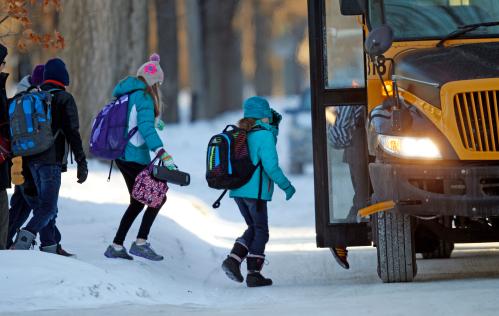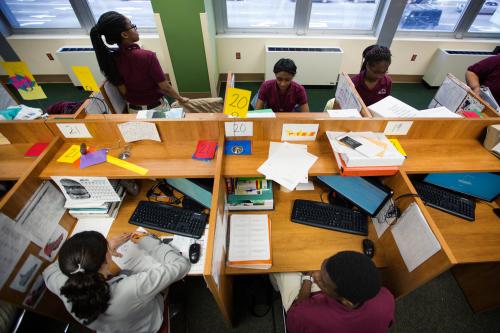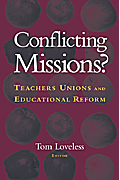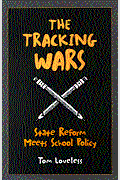Executive Summary
Charter schools offer choice to parents who would otherwise be constrained to having their children attend a residentially assigned traditional public school. The number of charter schools has increased steadily in the last decade, reflecting their popularity with parents and the general public. They vary substantially in their missions, the students they serve, and their effectiveness. Research suggests that charter schools are particularly effective in raising the achievement of low-income and minority students in urban areas. Charter schools are underfunded in comparison to traditional public schools and have particular challenges in finding and paying for school facilities. Authorizers of charter schools decide whether charter schools can enter the market, expand, or close, and they provide ongoing performance oversight. The school districts with which charter schools compete for resources and students are the most frequent authorizers of charter schools. The authorizing function seems very important in determining the quality of charter schools, but very little is known about the relationship between variations in authorizing and school quality.
The federal government’s role in charter schools has expanded of late and is likely to be an important element in the reauthorization of the Elementary and Secondary Education Act. The current federal role is a haphazard collection of laws, rules, funding preferences, and rhetoric that lacks coherence at the policy or action level. In that context, the Brown Center on Education Policy at Brookings gathered a group of prominent policymakers, practitioners, and researchers to address what the federal government should do if its policy were to increase the number of effective charter schools in the nation.
The recommendations for federal action advanced by these experts include: a) collecting and using more and better data on the performance of charter schools for purposes of authorizing, research, and informed parental choice; b) requiring states to provide equitable funding for charter schools relative to traditional public schools—including support for facilities; c) supporting higher standards for authorizing; d) revising rules and definitions that unintentionally disadvantage charter schools; e) promoting the growth as well as quality control of virtual charter schools; and f) finally and most importantly articulating and following through on a coherent policy with respect to charter schools.
Introduction
Charter schools are public schools of choice (rather than residential assignment) that are operated autonomously, outside the direct control of local school districts. Since the first charter school was established in 1992, the charter movement has grown to include over 4,900 charter schools in 39 states educating 1.6 million children.[i] In some cities, the penetration of charter schools is pronounced. In the District of Columbia, for example, over a third of public school students are now in the charter sector.[ii] New Orleans has an even higher concentration, with more than sixty percent of students attending a charter school.[iii]
The growth has been insufficient to meet the demand for charter schools. Many charter schools are over-subscribed, and few charter schools close for lack of adequate school enrollment. When the general public is surveyed, twice as many respondents say they favor charters as say they are opposed.[iv]
Charters do not have a single pedagogical identity. The best known chains, such as the Seed School, Uncommon Schools, and Knowledge is Power Program (KIPP), create highly structured routines with uniforms, strict rules, and numerous drills. But charters take many other forms, including single sex schools, schools for the performing arts, schools for science and technology, bilingual schools, schools for the disabled, schools for drop-outs, and virtual schools where learning takes place online.
The type of student entering a charter school is different from the traditional public school student. Relative to statewide averages, charter schools tend to attract a disproportionate number of students eligible for free or reduced price lunch as well as minority students, especially African Americans. Initial test scores of students at charter schools are usually well below those of the average public school student in the state in which the charter school is located.[v]
The Effectiveness of Charter Schools
The variety of charter schools is consistent with the original mission to provide new options to families and to promote innovative ways to organize a school and deliver a curriculum. But that same variety makes it difficult to draw conclusions about the instructional effectiveness of charter schools as a sector. Research findings vary widely, depending on the schools studied and the research methodology employed.
Nearly all large-scale studies that have examined the effectiveness of charter schools across many states have relied on statistical controls to handle differences in student background between students attending charter schools vs. regular public schools. Several of these studies find that students attending charter schools do no better than students attending regular public schools.[vi]
Critics of these studies point out that no amount of statistical adjustment for observed differences, such as correcting for divergence in the proportion of minority or low-income students attending regular vs. charter schools or adjusting for students’ prior achievement scores, can handle unobserved differences between parents and children attending the two types of school. For example, parents who enroll their children in charter schools may have different expectations for their children’s academic success than other parents. Or the students themselves may be different, e.g., students who transfer out of a regular public school into a charter school may have had particular problems adjusting to school. These unobserved differences in students and families may affect academic outcomes independent of the type of school students are attending.
Most of the research community agrees that the preferred research strategy for estimating the impact of attending a charter school is a randomized control trial. In such trials, two groups of students are compared. Both groups contain students whose families attempted to enroll the child in a charter school where there were more students applying for a spot than there were seats. For those oversubscribed schools a lottery is used to determine who is offered admission. By chance alone some students win admission and others do not. A comparison of academic outcomes for students who won vs. those who lost the lottery keeps everything about the two groups of students the same, on average, except the offer of admission into a charter school. Thus any difference in the academic outcomes for the two groups of students can only be due to the one thing on which they differ systematically, gaining admission to a charter school.
There are presently five randomized trials that have addressed the performance of charter schools. Four found positive charter school impacts on student achievement[vii] whereas one found no overall effect.[viii] The four studies finding positive impacts each involved charter schools serving minority populations, three in large urban school districts (Chicago, New York City, and Boston, respectively) and one in a smaller, low income city north of Boston. The study that found no overall impact examined charters across multiple states and types of locale. Interestingly, the multi-state study that found no overall impact nevertheless identified subgroup effects, such that students from poor, minority, urban backgrounds did better in charter schools in contrast to students from middle-class, suburban backgrounds, who did worse. Thus all the randomized trials are consistent in pointing to the success of charter schools in large urban areas.
One limitation of these randomized trials is external validity (i.e., the ability to generalize the results to other settings). Because there are few non-urban, sufficiently oversubscribed charter schools, the randomized trials have taken place primarily in large, urban areas with a high percentage of minority students. The results of the randomized trials may not extend to the areas outside of the major urban areas and more research using other methods is needed on the effectiveness of charter schools for non-urban areas.
The results also do not necessarily generalize to students whose families have not tried to gain admission for their children into a charter school. To the extent that the success of some charter schools depends on motivated parents who buy into the school’s approach and make the extra effort that may be required to get their child to measure up to the school’s demands, such schools might not succeed with students whose parents do not have that motivation or are unwilling to make that commitment. To date, this possibility has not been addressed with credible research.
A final limitation of these studies is that they focus on student achievement on reading and mathematics as measured on standardized tests. It is possible to expand the range of student outcomes, including long-term outcomes. For example, a study of charter high schools in Chicago and Florida found positive effects on both high school completion and college attendance.[ix]
In summary, the overall body of research on the academic effectiveness of charter schools suggests considerable variability in impact. Thus knowing that a school is organized as a charter school does not, in and of itself, say much about whether the school is good, bad, or mediocre. Some charter schools are unambiguously providing a more effective education for students than is provided by regular public schools serving similar students. Other charter schools are no better than the public schools with which they compete, and some are worse.
When the focus is on academic achievement, the variability in the success of charter schools raises important issues for researchers, policymakers, practitioners, and parents. For researchers, the challenge is to identify the active ingredients that differentiate more successful charter schools from less successful ones, with the awareness that those ingredients may involve interactions between what is being offered by a school and the characteristics of the students and families being served. For practitioners, the issue is how to use research findings to increase the effectiveness of the best charters and to raise the level of performance of lagging charter and public schools. For parents, the principal issue is how to be an informed consumer when making a choice of schools. A school’s organizational status as a charter school or a regular public school conveys far less information than needed by a parent to make the wisest choice.
Charter School Finance
Charters generally operate on a tighter public budget for current expenditures than traditional district schools, receiving by one estimate only about 80 percent of the per pupil amount received by district schools,[x] and by another only about 60 percent.[xi] The difference in charter school per pupil spending also varies widely from state to state.
Charter schools are also disadvantaged relative to traditional district schools when it comes to facilities. The vast majority of district schools operate in buildings that are publicly owned and were purchased and amortized many years ago. This leaves the district responsible only for expenses for operation and maintenance. In contrast, charter schools typically require new investment in the construction or lease of facilities.
Some but not all states allow or require school districts to make unused public school facilities available to charter schools – in some cases for free but often for rent. Some but not all states provide support for low-cost loans or bonding authority for charter school facilities construction. A few states provide a per-pupil facilities payment to charter schools that is intended to equalize the advantage that district schools have through their legacy of existing school facilities. Some states provide no facilities assistance whatsoever to charter schools. In such cases, facilities must be built, purchased, or leased by charter school operators in current dollars, as well as operated and maintained.[xii]
Issues surrounding facilities are among the most vexing faced by charter school operators. When the additional costs of facilities for charter schools are added to lower levels of reimbursement per pupil compared to traditional schools, charter schools operate at a significant public funding disadvantage.
Authorizing Authority
The authority to establish and operate a charter school varies from locale to locale and state to state. The most recent survey identifies 819 charter school authorizing bodies nationwide.[xiii] School districts authorize more charter schools (55 percent) than any other type of authorizer. Some observers believe this role for school districts involves an inherent conflict of interest since charter schools compete for students and resources with the school district that must authorize them. Other authorizing bodies include state education agencies and independent chartering boards (splitting about 30 percent of charter schools). Higher education institutions, non-profit organizations, and mayors/municipalities are responsible for authorizing the remaining 15 percent of charter schools. In some states, each of these authorizing mechanisms is present, whereas in other states authority resides solely with one entity.
Authorizers have a number of roles, including handling applications for charter school expansion or startup, contracting with charter school operators, providing performance oversight, and making decisions on renewal or closure. Authorizers vary substantially in how they carry out these roles. For example, some authorizers provide direct assistance to schools in meeting performance goals whereas others provide only guidelines and warnings. Some authorizers engage in rigorous application and renewal processes whereas others do not. Some authorizers provide ongoing oversight and evaluation whereas others are engaged in evaluation only at the point of a charter school’s application for renewal.
Most practitioners and policymakers in the field believe that the nature, independence, and operational procedures of authorizing bodies are a significant factor in determining the quality of charter schools. Researchers are only beginning to investigate this relationship. A recent analysis of authorizer types in Minnesota found no statistically significant relationship between the type of authorizer and mean levels of student achievement, although achievement in charter schools authorized by school districts was about 0.15 standard deviations lower than achievement in charter schools authorized by the state.[xiv] This study used statistical controls for the differences in the types of students served by different authorizer types, so the same cautions in interpretation apply to it as we described for the multi-state observational studies of the effect of attending a charter school vs. a regular public school. Much more research addressing the casual impact of differences in the types and practices of charter school authorizers is needed.
The Federal Role
Prior to the American Recovery and Reinvestment Act (ARRA) of 2009, federal involvement in charter schools was minor, with approximately $200 million appropriated annually through the Elementary and Secondary Education Act to make charter school grants to state education agencies and charter management organizations. During the 2008-2009 school year, federal involvement was approximately $1.40 per student.[xv]Neither the amount of funding nor the conditions of competition afforded an opportunity at the federal level to have much impact on charter schools.
ARRA provided the Secretary of Education with a $650 million innovation fund from which awards were to be made to education entities that had made significant gains in closing achievement gaps. The purpose of the awards was to expand the work of the award winners and to identify and document best practices that could be shared and taken to scale based on demonstrated success. The KIPP Foundation, a large national charter operator, was one of the big winners under the innovation fund competition, receiving $50 million to scale-up its leadership training model.
ARRA also provided the Secretary with roughly $4 billion to carry out a competition among states (Race to the Top) to support reform and innovation. Under the rules established for the competition, states had to meet a number of requirements for their support of charter schools to have a chance of winning an award. These requirements include lifting caps on the number of charter schools; establishing authorizing practices that hold charter schools accountable for student achievement; ensuring equitable per student funding; and providing facilities assistance.
These actions by the U.S. Department of Education presage the stance towards charter schools that the administration is likely to take in the reauthorization of the Elementary and Secondary Education Act. We are clearly at the beginning of a new era in federal policy towards charter schools.
Recommendations for Federal Action
In order to inform future actions on charter schools by Congress and the administration, the Brown Center on Education Policy, operating with the advice of its Charter School Task Force, convened a day long advisory meeting of leading charter school researchers, practitioners, and policymakers to address the question of what the federal government should do or refrain from doing to support the growth of effective charter schools.
The purpose of the meeting was to develop and harvest a list of ideas and recommendations that might be useful for federal action. There was no effort or intent to develop consensus recommendations. Rather, each participant was asked to put forward one or more recommendations for comment and discussion by all the participants. The following is a categorized and annotated list of the recommendations that generated interest among the participants and appeared to be actionable at the federal level.
Data Collection and Use
One of the main themes of the advisory meeting was the challenge of obtaining and using charter school data to inform research, policy, practice, and parental choice. One of the forms of data that is difficult to obtain but would be particularly important for research, policy, and practice is lottery results at the level of individual students. To the extent that charters are oversubscribed and have to use lotteries to determine who is admitted, having those lottery results recorded in a state’s longitudinal education data system would allow many important questions to be addressed that are currently challenging. For example, with lottery results and records of student achievement in hand, charter school authorizers could avail themselves of a valid estimate of the impact of a charter school when carrying out their oversight and renewal obligations. Currently authorizers rarely have any data available on student achievement other than the average performance of students in a charter school on end-of-the-year state achievement tests. But as we described previously, charter schools differ among themselves and from traditional public schools in the population of students they serve. A charter school serving a suburban middle-class population very likely looks much better on end-of-the-year state assessments than a charter school serving a population of urban poor and minority families. But what appears to be better performance may reflect little more than the advantaged background of the students being served. The availability of lottery data would allow the effectiveness of each school to be evaluated relative to the other schools serving the same student population.
The availability and accessibility of lottery data in state longitudinal databases would also be a boon to research. Consider, for example, the questions about the effects of authorizers that we raised previously. Examining lottery-based student achievement outcomes by type of authorizer or type of authorizer practice could shed considerable light on which forms of authorizing have impacts on student achievement. Lottery data can also be useful for studying other differences in educational experience for the students selected for the charter schools compared to students not admitted.
Connected with the availability and accessibility of lottery data is the quality of the lottery itself. Allowing charter schools to design and carry out their own admission lotteries is a recipe for undermining random assignment, both through naïveté and self-interest. For example, researchers who have sought lottery data from charter schools have encountered schools that claimed they held a lottery but did not. Further, hidden within what seems to be a fair lottery can be a variety of special admissions decisions, for example the admission of children of staff, or children who for whatever reason were treated as exceptions by school officials.
Even in the case of fair lotteries, it may have been advantageous for a school to conduct a more sophisticated lottery than simply drawing names out of a hat. For example, a lottery might be stratified to assure geographic or demographic balance when the size of the overall pool of applicants and admissions slots is too small for the law of averages to create a high likelihood of such balance.
Flowing from these observations are the following recommendations for the federal government:
- Fair and independent lotteries. Receipt of federal funds to support charter schools at the state and local level should be contingent upon charter schools being subject to lottery rules that require the design and implementation of lotteries by entities that are qualified to carry out the task, operate with clearly documented procedures, and are independent of the charter schools in which the lotteries are being conducted. One way to achieve this goal would be to require states seeking funding for charter schools to have established such rules as a precondition for application for funding.
- Availability of lottery data. Student participation in lotteries for admissions to any public school and the results of such lotteries should be a required student data element in state or district longitudinal data systems supported with federal funds. Competition for future federal statewide longitudinal data system grants or use of Title I funding to support state administrative data systems could be contingent on this condition.
- Use of lottery data for oversight. The use of lottery data by authorizers to carry out their oversight and renewal roles pertaining to the effectiveness of charter schools in raising student achievement should be encouraged. This goal could be achieved using the same contingent-funding mechanism described above, or could be pursued through guidelines and technical assistance in partnership with non-governmental organizations.
- Use of lottery data for research. Since 2005, nearly every state in the nation and the District of Columbia has received a substantial federal grant through the Institute of Education Sciences within the U.S. Department of Education to develop a statewide longitudinal data system. A statutory requirement of these awards is that the resulting data systems be used to facilitate research to increase student achievement and close achievement gaps. Yet many states have made no provision for researcher access to their longitudinal data systems or have allowed access only to those with the persistence and skill to strike a deal with a responsible state official. One of the principal rationales for charter schools is for them to serve as engines of education innovation. It is difficult to identify and reap the rewards of innovation without a serious and sustained research presence. It is time for the federal government to insist that recipients of statewide longitudinal data system grants demonstrate that they have met their obligations to facilitate research.
- Increasing data detail. All parties interested in identifying and scaling-up successful charter school practices would benefit from better information. Currently, most data elements that find their way into statewide longitudinal data systems are driven by federal reporting requirements under the Elementary and Secondary Education Act. Thus these data systems contain information on student test scores, student race, language, and disability status, student eligibility for free- and reduced-price lunch, and school and district identifiers. Important information is missing, including such things as curriculum in use, teacher characteristics, and as we have previously noted, lottery results. The federal government, working in collaboration with interested states and national charter school organizations, might generate a template for additional data elements that states or charter school authorizers could include in their routine data collections for their statewide longitudinal databases.
Information to Support Choice
Charter schools are by definition schools of choice. The promise of education choice includes improving quality and efficiency through competition among schools, enhancing opportunity for students of low-income families who may otherwise be trapped in ineffective schools, and spurring innovation. But the promise of choice in public education is constrained by the quality and timeliness of information on school performance that is available to parents.
Under current federal law, school districts are required to produce school report cards, but the information they include is incomplete and sometimes misleading. For example, the report cards include the percentage of students in a school who score proficient on state tests, which is strongly correlated with students’ family background, rather than student gains over the course of the year, which better reflect the performance of the school itself. Information about teacher turnover, parental satisfaction, and other important measures of school performance is not included.
In addition, school districts have demonstrated that they cannot be trusted to help parents choose schools based on school performance. As evidence, a federal study found that half of all districts required to offer school choice due to low performance did not notify parents of their right to choose a new school until after the school year had already started, and many used language that was too complicated for parents to understand. Choice cannot work if parents are blindfolded.[xvi]
The federal government has a role to play in providing parents with timely, transparent school data to support choice. This is particularly important for charter schools, which always require parental choice. Specific recommendations for federal action include:
- Report measures of school popularity. Federal requirements for school report cards under the Elementary and Secondary Education Act should be revised to include information on popularity of schools as revealed through the number of applications for admission received by charter schools and other schools of choice.
- We recognize that measures of school popularity derived from records of parental preferences expressed through applications for admission may sometimes distort the actual popularity of schools. Distortions arise through choice systems that encourage parents to game the system, for example by ranking their 3rd choice 1st because it has fewer applicants and thus offers a greater chance of admission through a lottery. Further, charter schools that cater to a community of interest that is sufficient to fill their slots may not want to engage in outreach or advertising because it would generate demand that they are not able to meet or interested in meeting. One reflection of this is the increasing prevalence of seats in all grades at popular charter elementary schools “selling out” through the lottery for admission to kindergarten. In other words, there is very low attrition in later grades of children admitted to kindergarten in these popular charter schools, meaning there is only a small chance of parents being able to laterally transfer their child into such schools from lower performing regular public schools.
- The first of these distortions can be eliminated by designing choice systems such as those in New York City and Boston that are difficult to game. The second distortion can be addressed in two ways: Providing information on the number of applications and probability of admission by grade rather than simply in aggregate would reveal differences among schools that are most evident at the first point of entry. Finally, we believe that making information on popularity available to the public and thus part of an implicit accountability system would create incentives for schools that are secret jewels to engage in more outreach to a wider community, which would enhance functional choice for parents.
- Report additional school performance data. School districts should be encouraged to report more data on school performance to parents than required under law (or the law should be broadened), with the new data elements being those that are empirically linked to improved student outcomes or valued by parents. Such data might include percentage of inexperienced teachers; truancy rates; availability of extracurricular activities, enrichment programs, and programs for children with special needs; and success of students at the next level of education, such as college enrollment rates for high schools. Encouragement to collect additional data could come in the form of developing and disseminating model reporting templates, recognizing exemplary information systems to support parental choice of schools, and providing support for research and development on the design of school choice information systems.
Facilities
One barrier to charter expansion is the availability of physical space. As one advisory meeting participant highlighted, an enthusiastic educator eager to start a charter school may not have the funding or the expertise in construction to identify, rehabilitate, or build new facilities. Recommendations for federal involvement in facilities include:
- Incentives for facilities access. Provide incentives to districts to allow charters to take advantage of surplus district facilities, for example by giving districts that do so priority preference points in federal discretionary grant competitions around school improvement and reform.
- Federal loans. Provide federal loan guarantees for facilities or providing direct loans for facilities that take advantage of the low Treasury rates.
- Single federal facilities program. Combine the existing federal facilities funding programs into a single coherent and efficient program.
Funding
Charter schools are often provided less funding per pupil for operating expenses than traditional public schools. Further, charter schools are frequently on different schedules for receiving funding compared to traditional public schools. For example, while the principal of a traditional public school typically knows well in advance of a school year what his or her budget will be, the leader of a charter school may not have a clarity on budget until after final enrollment figures are obtained, and may need to spend money on supplies, materials, and personnel before a state allocation of funds is in hand.
Current federal definitions of charter schools and educational programs also adversely affect charter school funding. For example, the longer school days adopted by many charter schools preclude these charters from qualifying for grants for after school programs under the 21st Century Community Learning Centers program because the definition of “after school” excludes a regular school day that lasts until late afternoon.
Another financial hurdle preventing the growth of highly effective charter schools is the financing of charter school authorization. Authorization is important as the authorizers determine which schools can open and provide oversight and accountability to ensure that poor performing charter schools are closed. The authorization process is a complex and expensive process and routinely underfunded.
Recommendations for federal action to create equitable public funding for charter schools financial inequities include:
- Equivalent per pupil expenditures. Make Title I funding contingent on per pupil expenditures that are equivalent across all schools that are eligible for Title I funding, including charter schools.
- Equivalent distribution timetable. Require that Title I funds be available for use by charter schools on the same timetable and with the same predictability as they are available for use by regular district schools.
Authorizing
Charter school authorizers decide whether charter schools can enter the market, expand, or must close; they enter into contracts for charter school services; and they provide ongoing performance oversight of charter schools. How well they do their jobs would seem to be a very important determinant of the quality of charter schools. Yet, very little is known about what works in authorizing, and authorizers typically are underfunded with respect to their responsibilities. Although school districts are the most prevalent authorizers, there is an inherent conflict between actions that support the growth of the charter sector and those that support traditional public schools. Recommendations for federal action include:
- Charter authorizer funding. Set aside a portion of funding for charter schools to allow a separate competition for awards to charter school authorizers who propose to develop and implement rigorous oversight processes, or require states to adequately fund the authorization process through new requirements in the reauthorization of the Elementary and Secondary Education Act.
- Rigorous authorizing process. Make the receipt of federal funding to support charter schools contingent on the presence of authorizing processes that are rigorous and have safeguards to prevent the interests of charter schools from being subverted by the interests of traditional public schools.
- Funding research. Provide funding for research on the design and consequences of authorizing practices.
Unintended Consequences of Federal Definitions
An issue that resonated with the experiences of participants in the advisory meeting is the unintended consequences of the definition of a charter school in federal regulations. To qualify as a charter school under federal rules, a school must admit students on the basis of a single lottery for all applicants if more students apply for admission than can be accommodated.
One unintended consequence of this rule is a significant disincentive for charter school operators to expand, for example, by taking over the operation of a low-performing regular high school. Such a high school would not qualify as a charter school if the charter school operator wanted to give preference in admission to students from its existing middle school. It would only qualify as a charter school if every student applying for admission had the same chance of admission through a lottery regardless of where those students had attended middle school. However, the motive for many charter operators to operate a high school would be to build on the scaffold for student success created in earlier grades through their charter elementary and middle school. Many would not wish to take on a high school population that had not benefitted from that earlier preparation. Thus if a charter operator takes the path it considers educationally best by giving admission preference to its own middle school students in a high school for which it assumes responsibility, it loses any opportunity for federal charter school funding for that high school.
Another unintended consequence of the federal rule requiring a single lottery for a charter school is that it precludes the use of stratified lotteries that could be designed to create schools that have student bodies with more geographic or demographic diversity than would result from a simple lottery.
The recommendations for federal action are:
- Lotteries for vertically integrated campuses. Change the federal definition of a charter school to allow the use of lotteries for vertically integrated campuses in the same way they are presently allowed for single campuses – thus just as a second grader admitted to a charter school in first grade would not be subject to a lottery to continue in third grade in that school, an eighth grader at a charter operator’s middle school would not be subject to a lottery to advance to ninth grade at that charter operator’s high school.
- Stratified lotteries. Consider changing requirements for lotteries to allow stratification on variables that promote wider and more equitable access to schools of choice or that assure greater demographic or geographical balance between lottery winners and lottery losers than the simple flip of a coin.
Virtual Charter Schools
There are presently over 200 virtual charter schools in operation in the U.S.[xvii] Virtual charter schools offer the promise of increasing the productivity of the education system as well as providing more equitable access to advanced and high quality coursework, but simply having coursework online guarantees neither lower costs nor higher quality.
Online education at the college level is proving itself competitive with the classroom experience. According to a survey of colleges and universities, more than a quarter of all students in post-secondary schools were taking at least one course online in the fall of 2008.[xviii] In k-12 education, virtual education is developing more slowly, but policy makers in nearly every state are intrigued by its potential. For one thing, the cost per student of virtual education is, in the long run, almost certainly less than that provided in brick-and-mortar classrooms. According to one survey of 20 such schools in 14 states, the average per pupil cost of online learning in 2008 was roughly half that of traditional public schools.[xix]
Little is known from rigorous research about the quality of virtual charter schools. Studies in Ohio and California comparing home-based virtual charter schools to traditional public schools have found significantly lower student achievement for the virtual school students.[xx] However, the researchers acknowledge that differences in the student population may account for the lower achievement (e.g., students facing significant academic problems in the traditional school leaving to try the virtual school). The remaining available research, which is also observational and does not support causal conclusions, has found similar student achievement outcomes for virtual charter school students and their brick-and-mortar counterparts.[xxi] Overall, quality is likely to vary substantially by course, provider, and instructor, just as it does in traditional settings.
The authorizing function is perhaps even more critical for virtual charter schools than for brick-and-mortar charter schools. Virtual charter schools have low financial barriers to entry because they do not require physical classrooms. This provides a desirable cost advantage but also permits fly-by-night operators to enter the market. Authorizers of virtual charter schools need to have rigorous approval and oversight processes in place to assure that new virtual charter entrants are of acceptable quality and that existing virtual charter operators produce learning outcomes that are on par with what similar students achieve in traditional settings.
The potential for particularly strong conflicts of interest exist when local school districts have authorizing authority over virtual charter schools because traditional public schools are most likely to be disrupted by the efficiencies and conveniences provided by virtual charter schools. These self-interests are likely to manifest themselves through the creation of unreasonable barriers to entry or expansion of virtual charter schools.
The recommendations for federal involvement with virtual charter schools include:
- Funding for research and development. Provide competitive funding for studies that examine the condition and effectiveness of virtual education in k-12, and for the development or improvement of virtual courseware.
- Shared quality standards. Provide incentives to states to work collaboratively to establish shared standards for virtual charter schools and to create funding policies that would allow students to enroll in recognized virtual charter schools that have out-of-state home offices.
Alignment of Resources with Policy
Although the current and previous administrations have supported charter schools and charter school growth, there are sometimes conflicts between broad policy and particular actions. For example, the recent Edujobs legislation, intended to prevent the layoff of teachers, did not extend funding to charter schools. The recommendation for federal action is:
- Alignment. The administration should have a clear policy on charter schools, and examine each piece of law, regulation, and guidance that affects charter schools with the aim of aligning them with its policy. The articulation by the administration of its charter school policy and alignment efforts, including the identification of legislative roadblocks to alignment, could undergird the reauthorization of the Elementary and Secondary Education Act, not only with respect to charters but also with respect to broader issues of parental choice in public education.
[i] National Alliance for Public Charter Schools (2010). Public charter school dashboard. Retrieved from http://www.publiccharters.org/dashboard/home
[ii] Turque, B. (2010, October 6). Charter school enrollment up nearly 6 percent. D.C. Schools Insider, The Washington Post.
[iii] Laskow, S. (2010). Necessity is the mother of invention. Newsweek, August 26, 2010.
[iv] Howell, W.G., Peterson, P.E., & West, M.R. (2009). The persuadable public: The 2009 Education Next-PEPG survey asks if information changes minds. Education Next, 9 (4): 20–29.
[v] Zimmer, R., Gill, B., Booker, K., Lavertu, S., Sass, T.R., & Witte, J. (2009). Charter schools in eight states: Effects on achievement, attainment, integration, and competition. Santa Monica, CA: RAND Corportation.
[vi] Braun, H., Jenkins, F., & Grigg, W. (2006). A closer look at charter schools using hierarchical linear modeling (NCES 2006-460). U.S. Department of Education, National Center for Education Statistics, Institute of Education Sciences. Washington, DC: U.S. Government Printing Office. CREDO (2009). Multiple choice: Charter school performance in 16 states. Stanford, CA: Stanford University. Zimmer et al., supra, note 5.
[vii] Hoxby, C. & Rockoff, J. (2005). School reassignment and the structure of peer effects. NBER Working Paper. Hoxby, C.M., Murarka, S., & Kang, J. (2009). The New York City charter schools evaluation project. NBER Working Paper. Abdulkadiroglu, A. Angrist, J., Cohodes, S., Dynarski, S., Fullerton, J., Kane, T., & Pathak, P. (2009). Informing the debate: Comparing Boston’s charter, pilot and traditional schools. Boston, MA: The Boston Foundation. Angrist, J.D., Dynarski, S.M., Kane, T.J., Pathak, P.A., & Walters, C.R. (2010). Inputs and impacts in charter schools: KIPP Lynn. American Economic Review: Papers and Proceedings 100: 1-5.
[viii] Gleason, P., Clark, M., Clark Tuttle, M., & Dwoyer, E. (2010). The evaluation of charter school impacts. Washington, DC: Mathematica Policy Research.
[ix] Booker, K., Sass, T.R., Gill, B., & Zimmer, R. (2010). The unknown world of charter high schools. Education Next, 10.
[x] Thomas B. Fordham Institute (2005). Charter school funding: Inequity’s next frontier. Washington, DC: Thomas B. Fordham Institute.
[xi] Center for Education Reform (2008). Charter school funding: Follow the money. Washington, DC: Center for Education Reform.
[xii] ECS StateNote (2003). Charter school finance. Denver, CO: Education Commission of the States.
[xiii] National Association of Charter School Authorizers (2010). The state of charter school authorizing 2009. Chicago, IL: National Association of Charter School Authorizers.
[xiv] Witte, J., Carlson, D., & Lavery, L. (in press). Charter school authorizers and student achievement. Economics of Education Review.
[xv] Sable, J. & Plotts, C. (2010). Documentation to the NCES common core of data public elementary/secondary school university survey: School year 2008-09 (NCES 2010-350 rev). U.S. Department of Education. Washington, DC: National Center for Education Statistics.
[xvi] Greene, J., Loveless, T., MacLeod, W.B., Nechyba, T., Peterson, P., Rosenthal, M., & Whitehurst, G., (2010). Expanding choice in elementary and secondary education, Washington, DC: The Brookings Institution.
[xvii] National Alliance for Public Charter Schools (2010). Public charter school dashboard. Retrieved from http://www.publiccharters.org/dashboard/home
[xviii] Allen, I.E. & Seaman, J. (2010). Learning on demand. Online education in the United States, 2009. The Sloan Consortium.
[xix] U.S. Census Bureau (2008). Public schools spent $9,138 per student in 2006. U.S. Department of Commerce.
[xx] Zimmer et al., supra, note 5. Zimmer, R., Buddin, R., Chau, D., Daley, G.A., Gill, B., Guarino, C.M., Hamilton, L.S., Krop, C., McCaffrey, D.F., Sandler, M., & Brewer, D.J. (2003). Charter school operations and performance: Evidence from California. Santa Monica, CA: RAND Corporation.
[xxi] Cavanaugh, C. (2009). Effectiveness of cyber charter schools: A review of research on learnings. TechTrends, 53, 28-31. Zimmer et al., supra, note 5.
The Brookings Institution is committed to quality, independence, and impact.
We are supported by a diverse array of funders. In line with our values and policies, each Brookings publication represents the sole views of its author(s).













